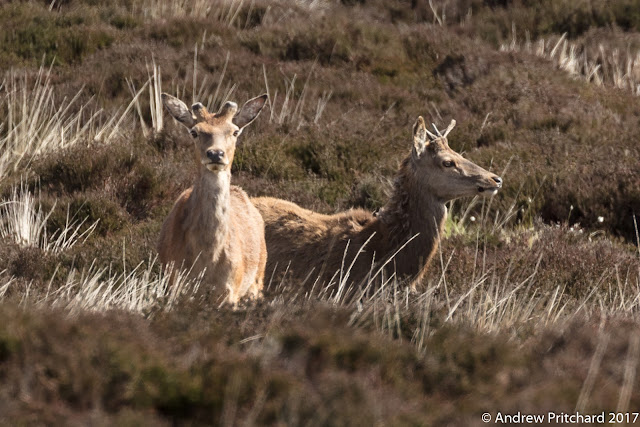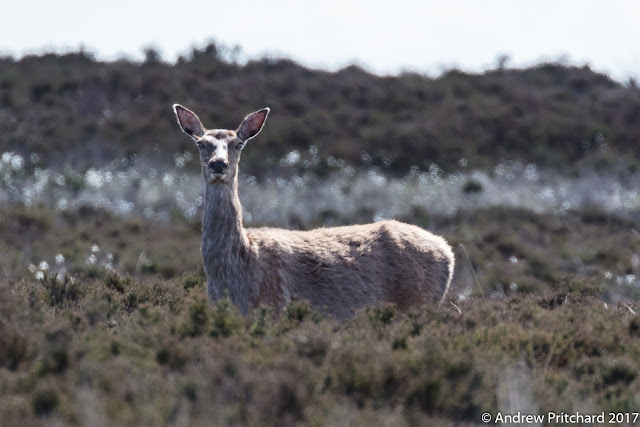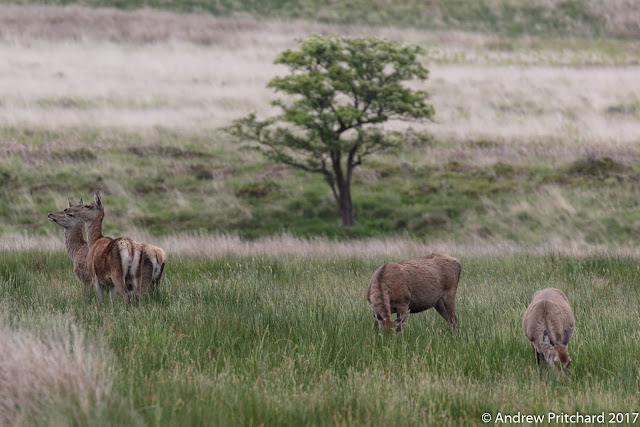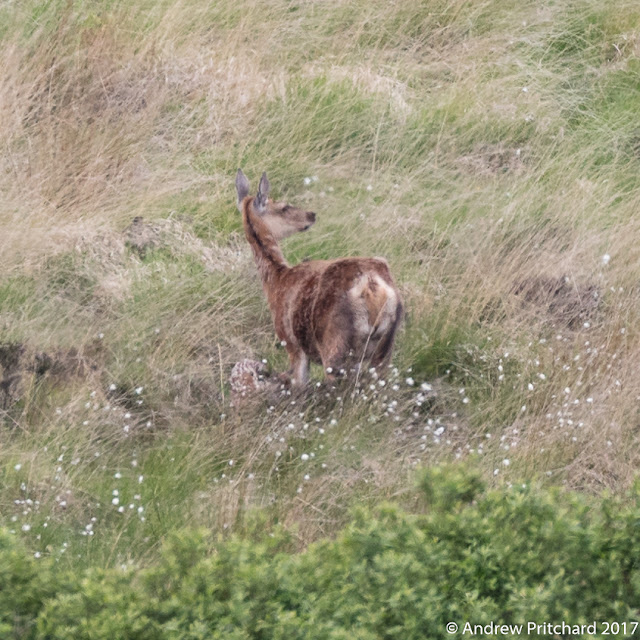May
 |
| Nothing to see here, move along. |
It's May and the weather can get hot and sunny. On the warmer days, stags may shelter from the heat and casual observation or disturbance by hunkering down behind features such as dry stone walls.
 |
| Really doing nothing. |
These antlers are well on the way to an impressive set. It takes a lot of energy and therefore food to re-grow antlers every year, so the stags must spend a lot of time grazing and then digesting their food. They may appear lazy, but in all likelihood these stags will be ruminating, digesting a full stomach of grass or other grazed or browsed plant material.
 |
| Pedicles and spikes. |
Here is a stag who has only recently shed his antlers, and has only the pedicles and the very beginnings of antler growth to display. Growing antlers is a time and energy consuming task, and begins again each year as soon as the previous years antlers are shed.
 |
| Stand off on the moors. |
What does a stag do when feeling argumentative, if he has no antlers for the moment? Two stags here seem to be squaring up, but with only pedicles and the smallest bud of antlers showing, how will they solves any dispute that develops? We'll find out later.
 |
| The best antlers. |
One stag here has easily the biggest antlers so far. He is surrounded by other stags with no real antlers on display as yet, as they move around the moorland in their male only group. They seem to be deferring to his already more impressive head gear, perhaps looking his way for guidance.
 |
| Angled pedicles. |
The pedicles on this stag seem to be angled at around forty five degrees. Is that an indication of previous large antlers? Many of the males shown here have more vertical pedicles, it remains to be seen later in the year, around September and October, whether stags with larger antlers tend to have less vertical pedicles.
 |
| Are you looking at me? |
These two stags seem to have taken a dislike to each other, but without antlers, what if anything can they use to settle arguments? The stag in the centre of the image gives a clue - he seems to be leaning back, placing his weight more on the back feet.
 |
| Come on then! |
Both stags here have their ears laid back, which is generally taken as a sign of anger or aggressiveness in most animals. It could also be a defensive position for the ears, as they folded back as far away from danger from any incoming attacks as possible. They are definitely not in a position for detecting sounds from the front.
 |
| Oof, a left hook to the jaw. |
So it becomes clear! When stags have no antlers to fight with, disputes or status within the group can be settled by a boxing match. This involves two stags rearing up onto their hind legs, and hitting each other with their front hooves.
 |
| I'm all right, I always look like this! |
The stag on the left looks somewhat shocked after receiving a left hook to the snout. But does the other stag have marks on his back, perhaps from an earlier bout? It looks like he has suffered a blow to left flank, and may have wounds there.
 |
| Are you dancing? |
This isn't a form of ritual dance, but two stags about to start a punch up. Both of them are balanced on their two back legs, with front legs relaxed and poised ready to lash out. The hooves of red deer are quite hard, and potentially dangerous when thrust rapidly into the face of another stag.
 |
| Ooof, a right jab to the throat. |
This looks like a painful right jab to the throat for one of the stags. The stag administering the hoof has what looks like raw flesh inside the left pedicle where his antler has recently been shed from. Perhaps this explains why he seems to be so short tempered - shedding and re-growing antlers looks to be a painful business!
 |
| Moving away from the action. |
The stag with the earliest antler regrowth also looks like one of the largest of the deer. Seen here moving away across the moor, he is definitely a more impressive animal than the others, with more body mass, bulkiness around the shoulders, and of course larger antlers.
 |
| I told you, I'm not backing down! |
Is this the same two as before I wonder, still arguing some days later? One pair of antlers is definitely growing well, with branching beginning to form. Boxing must be a common occurrence in the stag social calendar, when the stags have lost their antlers.
 |
| Doe in heather and cotton grass. |
Not far away on the same moorland, on the same day, we encounter a hind, making her way down off the moorland to the woods below. Woodland with grassy clearings seems to be a favourite place to give birth, where the calves can lie in the long grass until strong enough to move back to the herd.
 |
| Two hinds walking through long grass. |
Sometimes you need to take a friend with you for moral support. The size difference between these two hinds may indicate a mother daughter relationship, perhaps with mum taking her offspring to experience the new arrival. The older hind certainly looks a lot more rotund than the youngster.
 |
| Grazing near the trees. |
These hinds seem to be taking advantage of the lush grazing in the cattle fields near to the woodland before heading into the trees in search of a safe place to give birth. It is a short hop over a low fence to the wooded area just to the right of the outlier tree seen above.
 |
| Growing antlers with the hinds. |
But here are some antlers too. Is this a young male, or a hind with antlers? It is hard to tell from this view, though there is very little of the stags usual shaggy mane in evidence. Young stags do often stay with the main herd until two or three years old, so perhaps he is developing his first real antlers. They definitely do not look like the spiky antler growth seen on a brocket.
 |
| Something in the clearing. |
Glimpsed through the trees from some distance away, this hind appears to be nervously looking around for any signs of danger. She has found an area with deep grass, with plenty of trees screening the area, and also some cotton grass. I wonder if the presence of a plant which dots the ground with small white spots is significant to her choice?
 |
| The year's first calf? |
If you look closely on the ground to her left in the image above, you can see why she is looking so nervous. Lying close to her feet is a small brown shape, with white spots on it's flank. Her calf must still be too weak to walk, so may only be a matter of hours old.
If you would like to see more of the monthly posts from this blog, please subscribe using one of the buttons or links available. You can share this blog using the available buttons. Each blog post will comprise a selection of pictures taken by the author, reflecting red deer activity for the month with some explanatory text.
Comments
Post a Comment